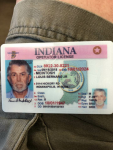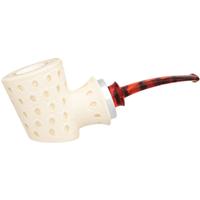I was one click away from being scammed trying to buy a Dunhill from what turned out to be a Philippines fighting-cock breeder...the story is even weirder than it already sounds, but fortunately I got just suspicious enough at just the right moment to prevent things from going through. I’m sorry to hear you were scammed. Big bummer!
I Got Scammed On Instagram, Careful Out There
- Thread starter Urban Briar CPG
- Start date
You are using an out of date browser. It may not display this or other websites correctly.
You should upgrade or use an alternative browser.
You should upgrade or use an alternative browser.
- Status
- Not open for further replies.
That sounds like the beginning to a great story. I am glad you stopped yourself.I was one click away from being scammed trying to buy a Dunhill from what turned out to be a Philippines fighting-cock breeder...the story is even weirder than it already sounds, but fortunately I got just suspicious enough at just the right moment to prevent things from going through. I’m sorry to hear you were scammed. Big bummer!
I have nobody to blame but myself really. There were two times when I thought to myself, "Is this a scam?" I need to be better at trusting my gut.
Sorry to hear about that. Not to diminish your experience or anything, but I would say the best way to avoid this sort of stuff is to know the person’s reputation. Do they have previous posts? Have they sold here? If it’s Instagram: are they followed by other pipe smokers? That’s why they have the 100 post minimum rule on here.
That sucks. I hear about it all too often and I’m sure my day is coming. I try to prepare myself by contacting known scammers, before their account is locked/banned, as a prospective buyer to see how they operate to generate some red flags in the future.
A few tips:
—A lot of these scams are people overseas acting like they’re in the US. Analyze their grammar for clues that English might not be their first language.
—If the email address is something off the wall batshit crazy, red flag. Take a look at the email address in the photo in the next item. Also, his “name” associated with the emails he sent was “God First.”
—Time stamps on emails can help, too. When they reply, if they don’t specifically delete all prior messages in the chain, it’ll put all of the old messages down in the body of the email and it’ll capture the time in each of the messages. They’re captured from that person’s computer’s timezone. Use that time compared with the correct timezone in the ad’s location to see if they match up.
In the example below, the seller claimed to be in Indiana. However, I was replying to emails almost immediately so take a look at the time stamp (this reply was sent ten minutes after I received his email). I was in Texas working nights at the time, not Ohio - I just said that since it’s close and I knew he’d offer to ship them, anyways, since it was a scam - so if he’s in Indiana, he should have only been an hour ahead of me in Texas.

—Ask for references. If it’s on a forum, get references from well-respected, long-time active members who have dealt with the person successfully. Also, always check out the reference, too. If they both joined around the same time and don’t post much, red flag. If you go back and look at all of their posts and it’s a bunch of meaningless drivel to get their post count up to seem like an active member, red flag.
—Google image search is your friend. Most of the time they’re “selling” something they’ve never had in their possession. 9 times out of 10 if you do an image search on their ad’s photos, you’ll find another webpage from which they’ve taken the photos.
—Smell test. If it’s too good to be true, proceed with caution. In the example below, the guy was trying to sell me a $2,200 binocular for $950 shipped. Okay.
—Always use a form of payment that offers fraud protection.
—The first thing I’ll do when dealing with someone new or that doesn’t have references I trust is to always ask for a photo of the item with some type of proof that it’s actually in his/her possession. An example is to ask something like, “Can you send me a quick picture of the (_________) on the arm of your couch with your right hand making a thumbs up beside it?” That’s a little over the top, but illustrates my point. I’m usually buying guns online so personal information is routinely shared.
I just ask for a photo of the person’s driver’s license covering up the trigger well on the weapon. Easy to do, not a common photo they’d be able to find online, and proves they have possession. Some folks will try to get tricky but paying a little attention goes a long way.
Here’s an example of a time where I played along with one of these bastards for educational purposes - same example the email above. The photos below are from a known scammer on a gun selling website before his account was banned. He claimed to have this binocular for sale. I knew going into the conversation that he was a scammer and had already taken money from someone, so I had zero intention of buying it, but I wanted to pretend like I was a possible buyer to familiarize myself with their tricks. When I asked for a photo of the binocular, I got this:

There were other photos, but this illustrates my point. When I asked for a photo of his driver’s license, I got this photo (I don’t mind posting it because it is involved with a scam and others should know the name and see the face, just in case. More than likely, the person on the DL isn’t even involved with this scam, someone has just stolen an image of his identification and is using it to seem more convincing. More on that later):

So if you’re still with me at this point, this is where it gets kinda good but also where you need to pay attention. I then asked for a photo of the driver’s license with the binocular to convince me that it was actually in his possession.
A bit of photo/video editing background - if you’re watching a documentary or a reality series or whatever, they always over-dramatize stuff which is typically accomplished by less than honorable methods, a bit of sleight of hand/lens, if you will. I don’t know how many times I’ve seen a scene where they make it look like someone is having an encounter with a bear, except they never show the bear and the person in the same frame. Often times, you can slow down the footage and analyze the surroundings to determine the two clips are completely unrelated, think bear footage from somewhere in Alaska portrayed as a close encounter in Idaho, for example - evergreen trees in the shot with the bear and deciduous in the shot of the person, different lighting, wind vs. no wind, etc.
This scammer made it WAY easier than that. Here is the photo I was provided when I asked to see the DL with the binocular:

Apart from it being the world’s smallest driver’s license, it’s fairly obvious that this is a poor cut & paste job combining the two photos from above. In fact, with better resolution, you can zoom in on the DL and see the black background on the corners from where he “cut” the image. The angles are the same on the box as the original photo as are the angles on the DL, making it pretty obvious that this is comprised of the two original photos.
This led me down a rabbit hole with the guy because it started getting interesting, then. His emails were coming back within minutes which made the next observation really important.
Who’s paying attention?
I got this photo emailed to me in the middle of the night in Texas. I was working nights back then and thought it was kinda odd that a dude from Indiana was up all night emailing me. If you look at his photoshop job on the DL/binocular picture, it’s a screenshot from his phone (another red flag, should just be an image if he had both items in his hand) but he didn’t crop out the data at the top of the phone. So I get this email at, well I guess it would have been right around 1:30am in Texas and noticed the time on his screenshot said 3:27pm. That means he’s twelve hours ahead of me, placing him somewhere in East Asia. Similar concept as the email time stamps referenced above, this is just additional confirmation or could be used if the scammer is deleting the prior messages from the body of his emails and you don’t see time stamps that way.
He went on to try to get me to send him a USPS Money Order to the name/address on the DL. I’ve since read that these are typically operations from another country who either have someone in the US helping them out, getting a cut of each deal. The other option is that the person on the DL doesn’t even know this is happening and someone is watching their mailbox to take the MO after verifying it was delivered with tracking. This is proof enough that USPS money orders are no more secure than lighting money on fire.
If you’re buying something with PayPal and you don’t know/trust the person, pay the extra money for “Goods and Services” so you have buyer’s protection. If you’re selling something, it doesn’t really matter. Someone above, I think @Casual said to view any request from a seller other than “Goods and Services” as suspicious. I don’t necessarily agree with this. When I sell things I almost always specify “Friends and Family” so I don’t have to pay the fee. It’s right at 3% so the larger the sale, the more money PayPal takes. I have no problem with a buyer wanting to use “Goods and Services,” I just ask that they add 3% to the purchase price to cover the fee. Since it’s their own protection, I don’t feel it’s my responsibility to pay for it as a seller. I would, however, be a little concerned if the seller refused to do the deal if I offered to pay for the buyer protection through “Goods and Services.” If he still gets the total he’s asking for, why should he care if I pay a little extra for the coverage?
Sorry for such a long post! I’m by no means a detective, and I was lucky to know going into this example that it was a scam so I could just spend time picking it apart to figure out what to look for. I share it willingly so that others might learn a few tips to hopefully keep from falling victim to one of these asshats in the future.
A few tips:
—A lot of these scams are people overseas acting like they’re in the US. Analyze their grammar for clues that English might not be their first language.
—If the email address is something off the wall batshit crazy, red flag. Take a look at the email address in the photo in the next item. Also, his “name” associated with the emails he sent was “God First.”
—Time stamps on emails can help, too. When they reply, if they don’t specifically delete all prior messages in the chain, it’ll put all of the old messages down in the body of the email and it’ll capture the time in each of the messages. They’re captured from that person’s computer’s timezone. Use that time compared with the correct timezone in the ad’s location to see if they match up.
In the example below, the seller claimed to be in Indiana. However, I was replying to emails almost immediately so take a look at the time stamp (this reply was sent ten minutes after I received his email). I was in Texas working nights at the time, not Ohio - I just said that since it’s close and I knew he’d offer to ship them, anyways, since it was a scam - so if he’s in Indiana, he should have only been an hour ahead of me in Texas.

—Ask for references. If it’s on a forum, get references from well-respected, long-time active members who have dealt with the person successfully. Also, always check out the reference, too. If they both joined around the same time and don’t post much, red flag. If you go back and look at all of their posts and it’s a bunch of meaningless drivel to get their post count up to seem like an active member, red flag.
—Google image search is your friend. Most of the time they’re “selling” something they’ve never had in their possession. 9 times out of 10 if you do an image search on their ad’s photos, you’ll find another webpage from which they’ve taken the photos.
—Smell test. If it’s too good to be true, proceed with caution. In the example below, the guy was trying to sell me a $2,200 binocular for $950 shipped. Okay.
—Always use a form of payment that offers fraud protection.
—The first thing I’ll do when dealing with someone new or that doesn’t have references I trust is to always ask for a photo of the item with some type of proof that it’s actually in his/her possession. An example is to ask something like, “Can you send me a quick picture of the (_________) on the arm of your couch with your right hand making a thumbs up beside it?” That’s a little over the top, but illustrates my point. I’m usually buying guns online so personal information is routinely shared.
I just ask for a photo of the person’s driver’s license covering up the trigger well on the weapon. Easy to do, not a common photo they’d be able to find online, and proves they have possession. Some folks will try to get tricky but paying a little attention goes a long way.
Here’s an example of a time where I played along with one of these bastards for educational purposes - same example the email above. The photos below are from a known scammer on a gun selling website before his account was banned. He claimed to have this binocular for sale. I knew going into the conversation that he was a scammer and had already taken money from someone, so I had zero intention of buying it, but I wanted to pretend like I was a possible buyer to familiarize myself with their tricks. When I asked for a photo of the binocular, I got this:

There were other photos, but this illustrates my point. When I asked for a photo of his driver’s license, I got this photo (I don’t mind posting it because it is involved with a scam and others should know the name and see the face, just in case. More than likely, the person on the DL isn’t even involved with this scam, someone has just stolen an image of his identification and is using it to seem more convincing. More on that later):

So if you’re still with me at this point, this is where it gets kinda good but also where you need to pay attention. I then asked for a photo of the driver’s license with the binocular to convince me that it was actually in his possession.
A bit of photo/video editing background - if you’re watching a documentary or a reality series or whatever, they always over-dramatize stuff which is typically accomplished by less than honorable methods, a bit of sleight of hand/lens, if you will. I don’t know how many times I’ve seen a scene where they make it look like someone is having an encounter with a bear, except they never show the bear and the person in the same frame. Often times, you can slow down the footage and analyze the surroundings to determine the two clips are completely unrelated, think bear footage from somewhere in Alaska portrayed as a close encounter in Idaho, for example - evergreen trees in the shot with the bear and deciduous in the shot of the person, different lighting, wind vs. no wind, etc.
This scammer made it WAY easier than that. Here is the photo I was provided when I asked to see the DL with the binocular:

Apart from it being the world’s smallest driver’s license, it’s fairly obvious that this is a poor cut & paste job combining the two photos from above. In fact, with better resolution, you can zoom in on the DL and see the black background on the corners from where he “cut” the image. The angles are the same on the box as the original photo as are the angles on the DL, making it pretty obvious that this is comprised of the two original photos.
This led me down a rabbit hole with the guy because it started getting interesting, then. His emails were coming back within minutes which made the next observation really important.
Who’s paying attention?
I got this photo emailed to me in the middle of the night in Texas. I was working nights back then and thought it was kinda odd that a dude from Indiana was up all night emailing me. If you look at his photoshop job on the DL/binocular picture, it’s a screenshot from his phone (another red flag, should just be an image if he had both items in his hand) but he didn’t crop out the data at the top of the phone. So I get this email at, well I guess it would have been right around 1:30am in Texas and noticed the time on his screenshot said 3:27pm. That means he’s twelve hours ahead of me, placing him somewhere in East Asia. Similar concept as the email time stamps referenced above, this is just additional confirmation or could be used if the scammer is deleting the prior messages from the body of his emails and you don’t see time stamps that way.
He went on to try to get me to send him a USPS Money Order to the name/address on the DL. I’ve since read that these are typically operations from another country who either have someone in the US helping them out, getting a cut of each deal. The other option is that the person on the DL doesn’t even know this is happening and someone is watching their mailbox to take the MO after verifying it was delivered with tracking. This is proof enough that USPS money orders are no more secure than lighting money on fire.
If you’re buying something with PayPal and you don’t know/trust the person, pay the extra money for “Goods and Services” so you have buyer’s protection. If you’re selling something, it doesn’t really matter. Someone above, I think @Casual said to view any request from a seller other than “Goods and Services” as suspicious. I don’t necessarily agree with this. When I sell things I almost always specify “Friends and Family” so I don’t have to pay the fee. It’s right at 3% so the larger the sale, the more money PayPal takes. I have no problem with a buyer wanting to use “Goods and Services,” I just ask that they add 3% to the purchase price to cover the fee. Since it’s their own protection, I don’t feel it’s my responsibility to pay for it as a seller. I would, however, be a little concerned if the seller refused to do the deal if I offered to pay for the buyer protection through “Goods and Services.” If he still gets the total he’s asking for, why should he care if I pay a little extra for the coverage?
Sorry for such a long post! I’m by no means a detective, and I was lucky to know going into this example that it was a scam so I could just spend time picking it apart to figure out what to look for. I share it willingly so that others might learn a few tips to hopefully keep from falling victim to one of these asshats in the future.
Last edited:
The surprising part about this to me is that the perpetrator clearly knew their pipe tobaccos.
My wife who sells her artwork through instagram had a similar attempt last week, in that the person trying it on had sought out a pretty niche product, dm-ed the right sort of questions about it and then tried to hoodwink her into revealing PayPal details.
My wife who sells her artwork through instagram had a similar attempt last week, in that the person trying it on had sought out a pretty niche product, dm-ed the right sort of questions about it and then tried to hoodwink her into revealing PayPal details.
Great rule of thumb really. Unfortunately, he was followed by many of the active Instagram pipe community. First red flag was he had a private account, and did not accept my follow request.Sorry to hear about that. Not to diminish your experience or anything, but I would say the best way to avoid this sort of stuff is to know the person’s reputation. Do they have previous posts? Have they sold here? If it’s Instagram: are they followed by other pipe smokers? That’s why they have the 100 post minimum rule on here.
He clearly knew a lot. He send videos of him going through his cellar. He actually has everything he is "selling" – he just doesn't ship it after you pay. He clearly knows he is selling to a community that has a very trustworthy base.The surprising part about this to me is that the perpetrator clearly knew their pipe tobaccos.
My wife who sells her artwork through instagram had a similar attempt last week, in that the person trying it on had sought out a pretty niche product, dm-ed the right sort of questions about it and then tried to hoodwink her into revealing PayPal details.
He clearly knew a lot. He send videos of him going through his cellar. He actually has everything he is "selling" – he just doesn't ship it after you pay. He clearly knows he is selling to a community that has a very trustworthy base.
And that's it...all I've ever experienced from fellow pipers both in the UK and US is extraordinary generosity of spirit.
What a shame.
ViperSting989 at the moment. After digging a bit, I came across some YouTube community videos warning about the guy way back in 2015.What’s his IG name?
Yup, there really are members who think of pipe smokers as a "brotherhood." It pays not to be a naif. Due diligence and large amount of skepticism is a good thing when passing money around on the internet. This entire thread is a grand teaching moment!
...I also opened a case with PayPal, which I hear doesn't hold up well when you use the friends and family feature of it...
I know everyone hates the fees but a 3% charge for scam insurance when dealing with perfect strangers sounds like a good deal to me.
I'd be willing to buy pipes with cash over mail for any longtime forum member here, but people on Instagram?
I did through Instagram, but not sure they will care much, as they don't have an option for "fraud" - only inappropriate content and using someones identity. I also opened a case with PayPal, which I hear doesn't hold up well when you use the friends and family feature of it.
All in all, It could have been worse. I mostly just want to let people know whats going on out there, I am sure some people are wiling to drop a lot more than I did.
They have an option for scam or fraud, I have just submitted a report on his account on Instagram.
ViperSting989
He has 1115 followers at the moment.
Since this scum bag has been operating for more than 5 years lets crowd fund an IT geek to disable/hack his accounts and hound him out of business?
I would be very hesitant to do a deal where I paid first on something like Instagram. As had been mentioned, get a PayPal account and don't pay using friends and family. Sorry you had the bar experience. I think most of us have at least one bag experience.
This guy may not have even been part of the pipe smoking public,just a scammer who learned enough from perusing the internet sites to do thisJust a heads up to you all out there – There is an active scammer out there on instagram. I had a pretty long messaging session about some cellar he was trying to sell off - Then he took me for $150 bucks. I am not sure the best way to protect ourselves from being scammed, so just wanted to alert you all.
The guys Instagram handle was ViperSting989 and was "selling" all sorts of McClelland tins, Esoterica, Dunhills. Once you get a price, he offers to throw in some other tins for a better price to "sweeten the pot."
I fell for it, sent the money and never heard a word from the guy. If your gut is telling you something is off, it is.
Its one thing to decide to finally purchase some vintage tins, its another to realize you just get burned. My first bad experience from the pipe smoking community. I have really only come across generosity up until now.
Sorry to hear. I have been scammed a couple of times using PayPal over the years if that helps!I I would at least contact Payal and they should able to look at his account and view his suspicious activity. Paypal views friends and family I believe as sending money to another person - not an item purchase.
Oh, wow.... I remember that guy.ViperSting989 at the moment. After digging a bit, I came across some YouTube community videos warning about the guy way back in 2015.
I only use F&F when I personally, physically know people, or else have dealt with them before and/or they have a Sterling reputation from years of online activity. Otherwise, it's Goods & Services and when people balk, I walk away.
- Status
- Not open for further replies.













